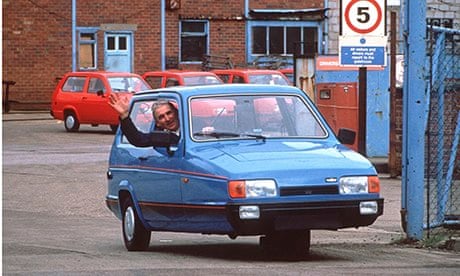Tom Karen, designer
I always get annoyed when people talk about the Trotters driving a Reliant Robin in Only Fools and Horses. It's actually a Reliant Regal van – a big ugly thing that had been around since the 1950s. In the 1960s, while I was working for a company called Ogle Design, I got the job of designing its replacement, the Robin.
The biggest challenge was coming up with a three-wheeled car that qualified as a motorcycle, meaning it could be driven without a full licence. Even though it's a four-seater with a four-cylinder engine, it still had to weigh less than eight hundredweight (about 400kg). This required a lot of innovations. One was getting rid of drip rails, the ugly roof guttering every car had back then. Ten years later, Fiat made a big deal about launching a car without drip rails. I told them we'd done it years before with the Robin.
The car's distinctive shape arose from not wanting a boot sticking out at the back, which had made the car version of the Regal look like three boxes stuck together. In 1968, I designed the Scimitar for Reliant, giving it a gently sloping rear window, which we now call a hatchback. I kept the look for the Robin, while its chassis was adapted from the Bond Bug, a sporty little three-wheeler I'd designed that hadn't done as well as we'd hoped. The bodywork was made from fibreglass because it was cheaper than metal. Everything was done as cheaply as possible.
In 1973, the Robin was finally launched as the most practical small car in Britain, something as revolutionary as the Mini was in the 1960s. There were four versions – standard, super, van and estate – with a top speed of 85mph. You'd be hard pushed to get caught speeding in a Robin, but it was cheap to run, license and insure. Hugely popular, it was on the market until 1981, returning from 1989 to 2001.
Comedians like Jasper Carrott joked about flipping Robins over, but they were very safe if driven properly. When we launched the Bond Bug, a journalist drove it too fast and turned it over but, because we had installed roll bars, the car flipped back on its wheels. We used the same bars with the Robin. I've seen the Top Gear where Jeremy Clarkson takes great pleasure in flipping one. He's a big chap, though. If he goes fast down a hill and makes a sharp left turn, he can't fail to turn over. But you might turn a four-wheeler over doing that.
People who still drive them love them – and there are owners' clubs. It's a nice little vehicle. Drivers of powerful cars might look down their noses, but the Robin was designed for a particular market. If you're making a car with a price tag of a few hundred pounds, you can't build a Rolls-Royce.
Dave Peek, Reliant engineer
I know the Robin has been voted the worst car ever, but the "plastic pig", as it was called, was a good little product: a design classic, really. And it had a huge following that kept Reliant going for years. Some amazing people bought them, too. I delivered Princess Anne's to Buckingham Palace. I think it was for the household staff, but she had several Scimitars, and it was good of her to support the company. I remember giving that Robin a service at the Palace, but many owners simply serviced them themselves.
The weight limits meant early Robins couldn't reverse, and there were teething problems. Any manufacturer can pump thousands into testing a car but the public will find a fault within two weeks. The doors would crack if you let go of them in the wind, but this was soon sorted. More troublesome was the steering wheel detaching itself from the chassis. Esther Rantzen's programme That's Life! kept on about this. Eventually, we had to do a major recall.
The factory didn't keep up with the times, but it was great while it lasted. I loved the sound of the engine ticking over like a sewing machine. They were amazingly economical, managing around 80mpg. In today's world, it would be an environmentally friendly car. It's a myth that they turned over. If you're used to driving a motorcycle, you know exactly what to do going into a bend. So it doesn't surprise me that Robin owners were recently named Britain's safest motorists. Clarkson should realise it takes a proper driver to drive one.

Comments (…)
Sign in or create your Guardian account to join the discussion